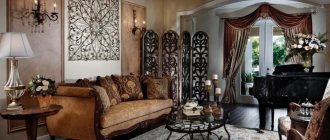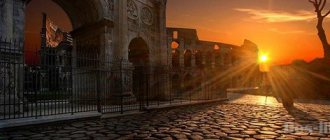How Gothic appeared
The date of birth of Gothic architecture is precisely known. Abbot Sugeria started rebuilding the dilapidated church at the French Abbey of Saint-Denis. Upon completion of the reconstruction, in 1144, a temple appeared before the world, built in a hitherto unknown style, later called Gothic.
The abbot revealed the symbolism of the unusual appearance of the church. According to his idea, the temple is a ship that carries the flock to the mountain heights. The analogy lay on the surface - the vaults resembled sails that caught the wind, and the high columns resembled ship masts. The nave (the space highlighted by columns) is translated from Latin as “ship”.
The first Gothic church was in keeping with the spirit of the times, it was at the same time significant, sublime and impressive. Success caused the spread and further development of Gothic architecture, first in France, and then in Germany, Italy, Britain and other countries.
Interior of Exeter Cathedral Source farm2.static.flickr.com
In its approach to construction, Gothic architecture was fundamentally different from the previous, Romanesque style. Architects discovered a new way of influencing the load on a building, in which the weight and pressure of the masonry were not distributed along the entire perimeter, as before, but were concentrated at certain points. At the same time, the load on other parts of the structure was minimal.
The discovery made it possible to replace the usual cylindrical vault with a new, rib vault, which received its name from the characteristic protruding ribs - ribs that carry the load in the Gothic frame cross vault. The revolutionary frame system opened up impressive possibilities for the construction of the highest and at the same time mystical-airy temples, some of which exceeded the height of the Cheops pyramid.
Structure of the frame system Source cf.ppt-online.org
See also: Catalog of companies that specialize in the installation of fireplaces and stoves
Baroque art. Baroque in painting
Baroque painting (in translation from Italian - “bizarre”) is usually called the artistic style that prevailed in the art of Europe in the 16th-18th centuries.
It is this era that is considered the beginning of the triumph of “Western civilization.”
It arose due to two important events of the Middle Ages. Initially, ideological ideas about man and the universe changed, thanks to the epoch-making scientific discoveries of that time. Subsequently, the need arose for the authorities to create an imitation of their own greatness against the backdrop of material decline. To achieve this, they began to use an artistic style that glorified the power of the nobility and the church. However, man began to feel like a doer and creator, and the spirit of freedom and sensuality broke through into the style itself.
This artistic style originated in Italy, particularly in Rome, Mantua, Venice, Florence, and spread to other countries after the Renaissance. In the 17th century, Italy lost its power in politics and economics. Its territory begins to be attacked by foreigners - the Spaniards and the French. However, Italy, exhausted by adversity, did not lose its position. Italy still remains the cultural center of Europe. The church and the nobility sought to show their power and wealth, but since there was no money for this, they turned to the sphere of art. Thanks to him, the illusion of wealth and power was created.
The main features of this style are solemnity, pomp, splendor, life-affirming character, and dynamism.
Baroque art has bold contrasting scales of color, shadow and light, combining fantasy and reality. Painting of this direction is characterized by progressive ideas about the complexity of the universe, the boundless and diverse world, and its impermanence.
A person is a part of the world, a complex personality that experiences life’s conflicts.
The interior began to be decorated with portraits emphasizing a person’s position in society. Also very popular are portraits of rulers, in which they are depicted with ancient Gods. Baroque is also characterized by still lifes depicting the gifts of nature.
Baroque artists
Famous representatives of the Baroque are Rubens, Van Dyck, Snyders, Jordaens, Maulberch.
Few artists, even outstanding ones, have earned the honor of being the founders of this style in the art of painting. Rubens turned out to be an exception. He created an exciting, lively style of artistic expression. This way of writing is characteristic of his early work, “Saint George Slaying the Dragon.” Rubens' style is characterized by showing large, heavy figures in action - they are excited and emotional. His paintings are endowed with enormous energy.
No one has been able to portray people and animals in mortal combat like Rubens.
Previously, artists studied domesticated animals, they depicted them together with people. These works usually demonstrated anatomical knowledge of the structure of animals. Their images were taken from the stories of the Bible or myths. The artist’s imagination generated real pictures of fighting people and animals in a real fight.
Other masters of painting also belong to this style, for example, Caravaggio and his followers. Their paintings are realistic and have dark colors.
Caravaggio is the most significant creator among Italian artists.
His paintings are based on religious subjects. He created a contrast of eras between late antiquity and modern times.
In Germany, Austria, Slovakia, Hungary, Slovenia, Croatia, Western Ukraine, Poland, and Lithuania, the Baroque style was intertwined with Rococo trends. Thus, in France, classicism was considered the main style of the 17th century, while baroque was considered a side trend until the middle of the century, but later both directions merged into one large style.
In the Russian Empire, Baroque appeared in the first half of the 18th century.
Russian Baroque did not have the mysticism and exaltation characteristic of European countries, but had national characteristics. The Russian style had a sense of pride in the successes of the state and the people. Painting freed itself from the Middle Ages and religion and turned to the themes of secular society, to the image of a human activist.
Everywhere, the evolution of Baroque came to the grace and lightness of Rococo. It was intertwined with this style. And since the 1760s it was completely replaced by classicism.
Baroque artists discovered new ways of interpreting form in space and its constantly changing vital dynamics. They activated the worldview and showed that life is one with the sensory and physical essence of existence. And tragic conflicts in Baroque painting created the basis of beauty.
Style development
The canons of Gothic architecture differ somewhat from country to country. In general, European Gothic is usually divided into three types, according to the following intervals:
- Early (lancet). Between 1140 and 1250, the transition to the Gothic style, exemplified not so long ago by Notre Dame Cathedral, was completed. A characteristic feature of the buildings is the combination of powerful walls, a majestic portal above the entrance and high arches. This is how mainly churches and cathedrals are built, and a little later castles.
Notre Dame de Paris, Notre Dame Cathedral Source www.ediscover.ru
- Tall (mature). The period lasted for two centuries. From 1194 to 1400, early Gothic improved, the frame structure became more complex, and the number of stained glass windows and sculptural groups increased. The Gothic style is gaining recognition as a trend in European urban architecture; its merits can be judged, for example, by the cathedral in Reims.
- Late (flaming). Covers the period from approximately 1350 to 1550. Much attention is paid to decorative details, the style becomes more refined and ornate (hence the name). A new development was achieved in the form of sculptural compositions on religious and secular themes. Late Gothic buildings include the Milan Cathedral.
Milan Cathedral Source wikimedia.org
Main features of Gothic architecture
The medieval cathedral was the center of city life, and was built to accommodate the entire city population. Preachers spoke on the square in front of the cathedral, traveling artists staged performances, and professors and students held discussions. Gothic architecture owes its external charm and performance qualities to the following characteristic features:
- The Gothic style is the characteristic, skyward appearance of all parts of the structure, including spiers, elongated stained glass windows, and narrow turrets.
- Frame construction system. Thanks to its appearance, buildings began to grow higher, and the thickness of the load-bearing walls became smaller.
Buttresses and flying buttresses Source i.pinimg.com
- Pointed arches. They coped well with the load of the upper arch, redistributing it to the lower structures. Thanks to the arrow-shaped arches, it became possible to do without many internal walls, which was impossible in the Romanesque style.
- Additional designs. Arches in the form of arcs and crosses, as well as hanging external semi-arches that can transfer the load outside the building.
- Various decor of the Gothic facade: archivolt (frames of arched spans), wimperg (pointed gable above a window opening or portal), “big rose” (central window of the cathedral), facade decorated with carvings.
Stained glass in a modern interior Source lunev-design.ru
Basic elements of the Gothic style: how not to get confused by the names
It is sometimes difficult to understand the language of architecture, but in fact, not everything is as complicated as it seems to the uninitiated. Let's look at the main structural elements of Gothic architecture.
Vaults
The engineering of the Middle Ages presented the idea of creating a ribbed cross vault, making such an element the main one in the design of cathedrals. The Gothic vault is characterized by pronounced profiled ribs of the working frame.
The load of the cross vault is distributed evenly across the corner supports
To reduce the weight of the element, the arches of the intersections of the vaults were strengthened, making the dome frame. This is how a new word appeared in the “architectural” language - rib from the French nervure - vein, rib.
The simplest rib vault consists of four perimeter buccal arches and two diagonal arches, called ogives. The star-shaped Gothic vault is characterized by auxiliary ribs: tiercerons and piers.
Diagram of a Gothic frame vault
Flying buttresses and buttresses
A flying buttress is an external stone thrust arch, the task of which is to transfer thrust to the supporting pillars - buttresses. In early Gothic, flying buttresses were hidden under the roof, obstructing the lighting, and therefore they were taken outside.
Flying buttresses of the unfinished Strasbourg Cathedral (Cathédrale Notre-Dame - Cathedral of the Virgin Mary)
A powerful Gothic pillar that counteracts the thrust of the vaults is called a buttress. In the Middle Ages, this element was taken outside at some distance from the wall and connected to it with flying buttresses.
The result is an effective solution for load transfer
Mosaic windows
Stained glass in Gothic style solved the problem of the effect of the presence of “Divine Light” inside cathedrals, and the color of the glass set a spiritual mood. Gothic stained glass windows vary in shape: they include lancet windows, rose windows, medallions, and ellipses with historical subjects.
The most interesting example is the rose window, which first appeared in architecture after the Crusades.
During the early Gothic period, the rose window on the west façade increased in size to match the width of the nave.
The pattern is radial and diverges from the center
The image was supposed to be religious, balanced, like the seal of Solomon. This is a symbolic connection of the eternal, mortal, finitude and infinity, the unity of matter and spirit
Main features of the interior
The combination of architectural innovations made it possible to significantly expand the internal space, which also did not go unnoticed. Thanks to the high pointed arch, reminiscent of a tree with branching branches, the interior of the Gothic building seems weightless and mysterious, despite the fact that the main building material was stone.
A characteristic feature of the Gothic interior is the skillful use of direct and diffused light. The huge space of the cathedral needed high-quality lighting. The required amount of light was provided by large lancet windows decorated with stained glass, ornaments, and turrets.
Windows made of colored glass played an important decorative role, showing parishioners colorful illustrations of biblical and secular subjects. The vaulted ceilings also contributed; their device made it possible to diffuse the light so that there were no shadows.
Knight's Hall Source i2.wp.com
Gothic is a distinctive style that has influenced all aspects of people's lives. The interiors of castles and town houses are moderately modest and, to the taste of a modern person, romantic. They are characterized by the following design techniques:
- Wooden panels were used to cover the stone walls, which were decorated with bright paintings, wood engravings and carpets. Windows in medieval houses were glazed, but no one had ever heard of curtains.
- The flooring was boards, stone, and later tiles. In the living area, the floor was covered with carpets.
Modern interpretation Source i.pinimg.com
- The traditional medieval ceiling had a beam structure with open rafters, while false ceilings were common. They were lined with boards or slats, and often decorated with paintings.
- A luxurious, richly decorated fireplace is a sign of French and English interiors. In Germany and other northern countries, from the mid-15th century they began to be replaced by tiled stoves.
Recreation area Source vseznayko.com
- The furniture, hewn with an ax from solid wood, is characterized by heavy proportions. In the 15th century, after the advent of the technology of making sawn boards, almost all modern types of furniture appeared. By the middle of the Middle Ages, furniture was richly decorated with carvings, gilding, and painting.
- The set of Gothic furniture included carved cabinets, tables and chairs, armchairs and beds with a canopy that protected from drafts walking through the spacious room.
- A familiar and extremely useful interior detail was a chest in which things were stored and on which people sat.
Late Gothic furniture
Gothic architectural style (c.1120-1500) 20 338 Section in the process of filling and adjustment
The term "Gothic", applied to the style of the late Middle Ages, was first used by Giorgio Vasari (1511–1574), half in jest and half in disdain, since the Italians believed that the Goths had destroyed the beauty of classical antiquity. This word expressed all the disgust that the Renaissance in general and Renaissance architecture in particular felt towards medieval artists, as well as the inability of the southern sense of form to understand and sympathize with the northern achievement. Gothic architecture was a development of northern Romanesque architecture and there is no clear dividing line between the two. To call the Romanesque style the style of round arches, and the Gothic style the style of pointed arches is superficial.
For more information on the general evolution of architectural design, see: History of Architecture (3000 BC – Present).
For a brief overview of artistic activity in the Middle Ages, please see: Medieval Art (c.450-1450).
Architectural terminology, see: Architectural Dictionary.
To understand the nature of Gothic art, we must remember the gradual stratification of medieval culture. It began in the monasteries of the West, where Latin became the language of the educated classes. For a long time the clergy hesitated to desecrate their parchment with the speech of the common people, although in 842 they recorded the Oath of Strasbourg of Ludwig the German, and after the year 1000 the first Italian and Spanish dialects appear in titular documents.
Romanesque art represented unity in plurality, but it could impose this unity on a heterogeneous culture only when it was supported by two forces that were closely connected with it, namely: the temporal power of the Empire with its spiritual sanctification and the spiritual papacy, always striving for temporal power . Over time, the Church became increasingly divided between the monastic orders and the clergy, who had completely different goals, while the secular authorities came into violent conflict with their vassals. Although their faith with its concept of a future life encouraged people to fear God and flee from the world, in practice they often behaved openly cruelly, but also unbridled sensually. Later, Dante deplored this discrepancy, which had long been recognized by those who had renounced the world to enter a monastery or taken refuge in the poetic world of dreams. Heroes, beautiful women, benevolent saints—these were noble and comforting figures to be looked upon with admiration. As the world of monastic fantasy gave way to chivalry, the cult of the Virgin Mary, which was constantly growing, also changed: the tribute of the courtiers raised the Mother of God to a new level of adored mistress; now she has become a Domina, a Madonna.
The transformation of form that occurred in Gothic art reflected a change in the entire Western culture. Isolated Romanesque monasteries and castles were replaced by cities in which a society developed that was different from what had existed before, but which still adhered to the concept of Christendom. In populous cities, Gothic cathedrals, built by secular hands, filled with all types of art, arose. Chronicles and charters tell of the religious fervor that inspired both nobles and common people during the Crusades.
The fact that he was admired by the whole people explains the secular nature of Gothic art. Cheerful and human realism replaced the old stylized forms. Instead of antique thistle, oak and vine leaves, decorative motifs appear. This is part of the same naturalistic tendency found in medieval literature, which presented legends of the Virgin Mary, as well as plays about miracles and mysteries, in a realistic form.
While the greatest achievements of Romanesque art expressed absolute submission to authority, Gothic art, at its peak, was a synthesis of late medieval thought, a reconciliation between spirit and matter, God and the world. When the people of the Enlightenment declared that scholastic philosophy was nothing more than an attempt to guide the camel of faith through the needle of reason, they forgot that scholastic philosophy flourished not after mysticism, but simultaneously with it.
The serene, flat-roofed Greek temple and the Gothic cathedral, restlessly reaching toward the heavens, express two fundamental attitudes of the mind that had very different influences on the visual arts of the time.
For more information see: Greek architecture (c. 900-27 BC); For more information on medieval arts and crafts, see: Medieval Christian Art (c.600-1200).
Origin of Gothic
The Gothic style, as a model for the entire Western world, first arose in France and only by studying it from the very beginning can we understand it, trace its development and follow its changes in other countries. In France, the system of chivalry developed faster than anywhere else. Language flourished in poetry and scholasticism was taught everywhere, not only in Paris; France stood at the pinnacle of Western culture. Christian art was no longer confined to the court and the old aristocratic monastic orders, but became the common property of the nobility and the merchant class, as well as of the new orders of Franciscan and Dominican friars who mingled with the people.
At the beginning of a new era, a new Gothic style was born, although no one realized it at the time. When Abbot Suger of Saint-Denis began to erect the altar of his abbey in 1140, consecrated on June 11, 1144 before an assembly of secular and spiritual princes, he did not suspect that he was present at the birth of a new style. In a very thorough and detailed report, he recorded everything from the quarrying of the stone to the inscriptions on the superb stained glass windows. So far there has been no reference to the new style. For people of this age, Gothic was a natural expression of their essence.
When the Gothic style, after long oblivion, was finally rediscovered, it was some time before its development was fully understood. Lefebvre-Pontalis's statement at the end of the 19th century that "Gothic art has its entire origin in the ribbed vault, which, like a grain of corn, contains the germ of a rich harvest", expressed the general opinion of scientific positivism, was repeated again in 1922 . If this statement is true, then the technical component most influenced the origin of the style, which was to last for centuries and influence sculpture and painting as much as architecture.
We can go further and mention the Islamic pointed arch that the Crusaders saw in the East, not to mention the influence that Arabic literature and the Arabic humanities had on France at that time. It cannot be denied that in artistic design Gothic art owes much to the East, but no one who looks at a Gothic cathedral without prejudice can explain it in terms of a ribbed vault or a model of Islamic art which is not functional but decorative.
Gothic Architectural Design
Only in psychological research of the present century has a correct approach to the problem of the origin of Gothic architecture become possible. During the last century a huge amount of detail has been collected and now, after further research, we have a clear idea of the order of succession of individual buildings and can to some extent explain the origin of the Gothic style.
There are many transitional churches with flowing vaults or pointed arches that remain essentially Romanesque in concept; while on the other side there are Gothic churches, which are dominated by ancient forms. If we want to draw a dividing line between Romanesque and Gothic architecture, knowledge of the individual parts is less important than understanding the architectural concept as a whole.
The church of Saint-Etienne at Caen, consecrated in 1077, exhibits, in a purely Romanesque sense, a direction which in itself would be sufficient to initiate a new style. The huge western front, built around 1080, rises above a minor base, and the upward trend is unmistakable. But only in places does the building break away from the cubic mass and begin to move. More interesting than the Cathedral of Angers and the Cistercian church of Pontigny, which in Anjou and Burgundy embody the early Gothic style, is the Cathedral of Laon, begun around 1165. Its facade clearly shows that the transition to Gothic could have been carried out completely independently of the pointed arches. Here the architectural tendency of the 12th century, the period of French early Gothic, is expressed with amazing completeness. No line, no surface any longer exists in isolation, as in a Romanesque building. If one imagines the towers of Laon with their tall octagonal spiers, each floor loses its obvious distinction and seems to move on to the next. Through the connecting links, a sense of living movement is introduced into the fabric, which vigorously pushes itself upward, not in one go, but with repeated efforts, while the diagonal corner elements give angled views that catch the eye from any vantage point.
By the 12th century, the next stage of this logical development had been reached at Chartres Cathedral (1194-1250) and Notre-Dame Cathedral in Paris (1163-1345). Reims Cathedral, founded in 1212, is even more free and bold in form. (Note: Reims Cathedral was a major influence on American architecture: see, for example, St. Patrick's Roman Catholic Cathedral in New York (1858-88), designed by James Renwick, 1818-95.) Finally, all earlier trends were unified to Amiens Cathedral, built in 1218-88. This is the purest embodiment of the Gothic style, which provided an example of "High Gothic" from which all of Western Europe could learn a lot.
Such pure forms are of great importance to the modern observer, who too easily forgets that entire generations worked to build medieval churches, most of them Romanesque churches restored or enlarged by Gothic builders. Thus at Amiens we see four-centred window openings high in the left tower, and the large rose window in the center is decorated with a characteristic convex design. A fine example of the High Gothic form of a rose window is in the transept of Notre Dame. The classical era of "High Gothic" in France roughly coincides with the reign of Louis IX (1226–70). In a very short time the country was covered with new cathedrals, built of shining white sandstone. In the volatility of the architectural masses, this art has reached its limits. For example, Sainte Chapelle, Palais de la Cite, Paris (1241-48), founded under Louis IX in 1243, is a single-nave church attached to a three-aisled church. In its superstructure, wide four-sided windows almost completely replaced the wall. For more information on the Sainte-Chapelle in Paris, see: Rayonnant Gothic architecture (1200-1350) - compare with the west façade of the Sainte-Chapelle in Vincennes (1379-1480), which illustrates Flamboyant Gothic architecture (1375-1500).
Compared to the magnificent new churches in Normandy and central France, those in the southern part of the country were rather cold and unimpressive. Only in Burgundy did a small group of churches adopt the Gothic style and transmit it to Geneva and Lausanne, where the finest Gothic cathedral in Switzerland is located.
After the Gothic reached its peak in France and reached its logical apogee, there was a natural pause. In Normandy the old, clear, but rather sober spirit of the country was again felt, less in the building of great cathedrals like that of Rouen than in the new buildings at Coutances and Bayeux, where the famous Bayeux Tapestry (c. 1075) is located. Bourges Cathedral dates back to 1179, but after many delays it was not completed until the fourteenth century. It has five aisles and two inner halls, like the altar of Le Mans Cathedral, the inner halls being higher than the outer ones. This, of course, tends to destroy the spatial unity of the interior, but expresses the essence of the Gothic system. It is now necessary to briefly describe this system in order to see how the Gothic style developed in France was adopted in the rest of Europe.
Features of the Gothic style
Something of the old traditional Romanesque cathedral plan is preserved in the simple Gothic church. The layout of classical cathedrals was developed and improved to the highest degree. Construction needs have led to changes. The Romanesque round arch required very massive supports to support the weight of the walls, but even so the thrust of the heavy transverse vault constantly threatened to push the walls out of plumb. An attempt to free them from the load inevitably led to a pointed arch
, which made the pressure lines almost vertical. More important was the ability given by the pointed arch to span spans of unequal size with arches of equal height. This restored the freedom that had been lost in the Romanesque "involved" system. The tyrannical square of the central nave can now be divided into two rectangles, each harmonizing with the square niche of the transept. The difference between arcade columns and niche columns was abolished; the rhythm was less insistent, but the orchestration was much richer. The heavy vault that dictated the entire structural system of the Romanesque church was replaced by light joints that were distributed in panels between intersecting ribs. Only the ribs, and not the entire heavy arch, carried the load.
To prevent the walls from being pushed out of plumb, the Gothic building on the outer walls had strong counter-columns, from which floating supports
, like support arms, reached the side passages. The structure was installed on the outside of the building so that the nave could rise freely. In Romanesque churches the ratio of height to width was 2:1, now it became 3:1 and even more, so that the eye could no longer accept it. The nave had three or five aisles, while the transept usually had three. The chapels continued around the polygonal altar, the carefully thought-out plan of which now caused no problems, since the most difficult areas could be covered with vaults. The pillars take the form of clusters of half and three-quarter columns (called shaft vaults), so that the cylindrical core almost disappears. The ascending parts of this cluster, which support the longitudinal and transverse ribs, are stronger than the others, while the lighter shafts connect to the diagonal ribs. From these grouping stems, the stone seems to stretch upward like a plant, so that no one will ever notice the downward load.
To avoid any weight on the exterior of the Gothic cathedral, small pointed pinnacles are placed on towering buttresses. A pyramidal spire rises above the quadrangular body of the pillar
.
At the corners of the masonry, small sliders are directed upward, connecting at the top of the spire, in the finial. Sometimes decorations are in the shape of living or mythical creatures, for example, gargoyles. The greatest concentration of ornament is on the facade. Above the gate, which follows the roof motif, rise peaked gables with their cornices, and the triangular space is filled with Gothic tracery
, filling and framing the pointed windows. It was in the "royal galleries", which in French Gothic often appear above doors, and especially on their jamb stones or casings, that Gothic sculptors showed their greatest skill.
Gothic Architectural Sculpture
To understand Gothic sculpture, we must first consider it in France. At that time the south of France was still rich in Roman sculpture (and it is entirely dependent on Greek sculpture), which the sculptors of Saint-Trophime in Arles, Saint-Pierre, Moissac and the abbey church of Saint-Gilles adopted as their original model. The Roman practice of turning the porch into a decorative element was much better suited to the Gothic than to the Romanesque way of life, where free-standing cubic fabric was included only in doors with shallow frames. In Gothic architecture, for the first time, it was possible to see imagination expressed in the richness of biblical art - in the form of relief sculpture - around portals and doors.
Throughout Europe, in France as in Germany, wise moderation became the standard of aristocratic life. Despite the differences in style and costume, the prophets depicted in the sculptures of Strasbourg Cathedral and the Virgin of Krumau make equally restrained and solemn gestures with calm nobility. The human body, for the Greeks the expression of the soul, now had to surrender to the idiom of clothing. The body, which Francis of Assisi called Brother Ass, was a nonentity for Gothic artists.
From 1250 in France and from 1300 in Germany, churches in the Gothic style were built almost entirely by secular architects and masons. The old Masonic corporations were replaced by permanent guilds. Individual stone sculptors and their students sometimes marked their work with their own personal marks, but they were all inspired by the same ideal. Gothic sculpture can be considered as a homogeneous creation. Although the figures on Notre-Dame in Paris were damaged during the French Revolution and were restored in the 19th century by Violier-le-Duc, we can study a comparatively early and severe style associated with the style of these figures in the statues around the door of Amiens Cathedral, made around 1240 The figure of Christ at the main entrance, "beau Dieu d'Amiens", recalls two thousand figures and reliefs, large and small, from Chartres, most of which still retain Roman rigidity. But it is in the main facade of Reims Cathedral, built at the end of the thirteenth century, that French Gothic sculpture reaches its highest level. Compare: Romanesque sculpture (1000-1200).
German Gothic design
"High" Gothic, which developed in France, was always a foreign form in Germany; there the construction of the greatest monument of Gothic art, Cologne Cathedral (1248-1880), the foundation of which was laid in 1248, stopped after the completion of the altar. Construction resumed in the sixteenth century, but by 1560 the will and means to continue seemed exhausted. Work began again in 1862, and by 1880 it was completed. His site plan was developed in the Middle Ages on the lines of Amiens and Beauvais. The interior with light streaming in creates the perfect impression of a classic Gothic cathedral.
In 1208, before the construction of Cologne Cathedral began, the altar of Magdeburg Cathedral was built on a French model, and between 1227 and 1243 the Liebfrauenkirche building in Trier was built in the form of a circle intersected by a cross, a layout very different from the usual French plan. On the Rhine, in Strasbourg or Freiburg, Western influence was still very strong, but this is not visible further east, although even there, as chronicles often record, churches were built by masons brought from France.
With its brick buildings, a material that required a simpler form of ornamentation and a different arrangement of walls, northern Germany enriched the Gothic style. Inexpensive material made it possible to plan large buildings, the most striking example of which is Marienburg, which in its large banquet hall demonstrates the unsurpassed craftsmanship of the late Gothic.
With them and with buildings such as Hallenkirchen or St. George's Church in Dinkelsbühl, one can reach a point beyond which new architectural forms were created.
On the facades of German medieval cities, over time, the Gothic rebellion gradually - although not without repetitions - established itself in the calm rhythm of the Renaissance, stubbornly adhering to Gothic forms. The same was true in the Netherlands, where, towards the end of the Gothic period, many wealthy market towns had erected ornate town halls and guild halls: long buildings with bay windows and high pediments. A tall, powerfully built tower, a belfry, rose defiantly above the roofs of Brussels, Bruges and other cities. The Gothic style conquered the entire North. In 1287 in Sweden, Uppsala Cathedral was built by a French architect, while in Norway the cathedrals of Stavanger and Trondheim were based on English Early Gothic principles.
NOTE: Gothic forms in Germany endured longest in Gothic sculpture in Germany, in particular in the magnificent wood carvings of Tilman Riemenschneider (1460-1531), who made the famous altar of the Holy Blood (1499-1504, Rothenburg), Veit Stoss (1445-1533 ), best known for the High Altar of St. Mary's Church in Krakow (1484); and Michael Pacher (1435-98), famous for the altarpiece of St. Wolfgang (1471-81).
English Gothic style
The new style of architecture came to England through Normandy earlier than to Germany. However, it was in English Gothic architecture that the new style found its widest scope. In their convenient mixture of ecclesiastical buildings and the residences of the clergy, in their quiet seclusion behind protective walls and gates, English cathedrals are a charming picture of the Middle Ages. They are not always located in the city center, as on the continent; often a green churchyard surrounds the cathedral, sometimes it adjoins open areas. Following the old Norman style, the base of the cathedral with its various departments is of great length, and to receive processions of pilgrims the choir was often extended at the eastern end.
The Gothic system was brought to Canterbury in 1175 by William Sens, who rebuilt the local cathedral. In the early English style (1175-1250) the pointed arch was victorious, but it was not until French influence was completely dominant that the English tendency towards horizontal lines was suppressed. Salisbury Cathedral, built and completed 1220-58, must be regarded as the best example of this style. In Wells Cathedral, the transept and nave, as well as the facade with its extraordinary wealth of decorative figures, are still early Gothic, and the choir appears in the 15th century.
The "High Gothic" or decorated style, 1250-1375, appeared in England almost fifty years later than in France. It is rightly considered an English style, since it did not have the logical character of the French Gothic; it fully embraced decorative detail and became the first style to make extensive use of flowing lines in tracery art, as well as the graceful fan-shaped external decoration favored by the English from the very beginning of the 14th century, the Renaissance in the late Gothic style. The monastery of Gloucester Cathedral is one of the most perfect creations of its kind, in which English art seems to anticipate the course of evolution and serves as the starting point for the French Flamboyant style, which appeared before 1375. France, the birthplace of the Gothic style, had much to learn from the innovations of the English architectural language.
While Exeter Cathedral, the main parts of which were built in the same style, is the purest example of the English High Gothic of 1327-69, the nave of Winchester Cathedral, restored after 1393, with its magnificent barrel vault, effectively articulates its supports and blind galleries on the site of the Gothic triforium represent a transition to a new style. The four-centred arch, which was introduced into England after 1290 and was still the predominant form in Winchester Cathedral, was slightly flattened around 1450, becoming the "Tudor arch" of the following period, of which the best and most numerous artistic examples can be seen in Westminster Abbey We'll come back to this later.
In terms of sculpture, while England was closely associated with France, English Gothic sculpture was not very different from continental sculpture. The smaller doors of English cathedrals forced large decorative elements to be placed on the facades. In Wells, more than six hundred figures escaped the iconoclastic fury of the Puritans and they give a clear picture of English sculpture of the period.
The Gothic style emerged in England during the architectural era of the late 18th century as part of the "Gothic taste" and the later Gothic Revival that dominated much Victorian architecture (c. 1840–1900).
- Gothic in painting
- III International Festival of Architectural Environment Design DAS FEST in Kyiv
- Architectural ecology of the city
- Exhibition “Architecture of Memory” 18+
- Exhibition “Architecture of Memory” 18+
- Architectural lighting based on LED luminaires
- Exhibition “Academic drawing in architectural education: Gennady Ovcharenko (MARCHI)”
- Exhibition “VKHUTEMAS-100. Portholes of tomorrow's cities. Architecture faculty"
Neo-Gothic and modernity
Interest in Gothic architecture was revived at the end of the 18th century and was marked by the emergence of a new direction - neo-Gothic, characteristic, for example, of the campuses of reputable educational institutions. Secular buildings also appeared, for example, the city council building in Munich or Berlin.
The Gothic interior design of the houses of noble Europeans took shape towards the end of the 19th century, when the fashion for lush and at the same time gloomy decor in the style of a knight's castle appeared. Today it can hardly be called universal: it is of little use for decorating a standard living room, but it looks good in a spacious room in a country estate. To embody the modern Gothic style, one cannot do without a certain stylization and the following elements:
- Spacious room with high ceilings and large windows.
Gothic bedroom Source i.pinimg.com
- Use of natural materials: wood, stone, metal.
- Characteristic palette: blue-black, golden, brown, violet, emerald, dark blue, rich red and silver.
Interior with fireplace Source roomester.ru
- To prevent the interior from becoming too gloomy, the palette is diluted with light colors, or, as an option, mixed with other styles.
- Furniture with medieval charm: heavy, carved, with forged parts, decorated with gilding and painting. Upholstery made of luxurious fabrics, velvet or brocade in dark shades will look harmonious.
Light Gothic Source kstudiosdesign.files.wordpress.com
- Accessories. Details are an important part of the medieval setting. Don’t forget about stained glass windows, themed tapestries, and bronze candlesticks. The worn leather chest looks like an atmospheric detail.
- Lighting. The finishing touch will be a forged chandelier with lamps in the shape of a candle in the wind, which will be complemented by suitable lamps and sconces.
Kitchen-dining room Source roomester.ru
Modern ready-to-wear style: characteristic features, distinctive features
The Middle Ages left its mark on the appearance of melancholy fatalists. But they adopted only a narrow, laced waist; otherwise, the fashion trends of that time have little in common with the appearance of modern Goths.
These grotesque personalities rather took on the role of a victim of the Inquisition, who appeared in our world with a reminder of eternal sorrow, mourning, and the frailty of existence. But believe me, deep down, none of them are going to die, and the exquisite beauty of death is a way to present oneself to the world and be noticed.
If you want to accurately identify representatives of this subculture in a crowd or try on clothes in the Gothic style, remember the main features:
- predominance of black with contrasting accents - white, red;
- dark rich colors are allowed - purple, burgundy, green, blue;
- clear silhouettes, straight flying lines;
- frank extravagance with subtext for adults;
- vintage or ultra-modern dresses with a complex cut;
- voluminous skirts, mini or maxi length;
- frill, lace, mesh, lacing;
- corsets and belts, mainly over clothing;
- loose black blouses, T-shirts, shirts, turtlenecks;
- an abundance of leather - trousers, skirts, leather jackets;
- rough shoes with platforms or high heels (grinders, camelots, ankle boots);
- eccentric umbrellas, veiled hats, long gloves;
- massive white metal jewelry;
- expressive contrast of dark hair and completely white face;
- deliberately careless aggressive makeup in black and blood-red tones.
Preferable fabrics:
- velvet;
- atlas;
- silk;
- leather;
- vinyl;
- brocade;
- taffeta;
- lace;
- organza.
The Goths have a fair share of aristocracy in both women's style and men's clothing. Long black coats and raincoats, a top-hat, and on special occasions a tailcoat, what a London dandy. But still, the image of a modern goth girl deserves more attention.











